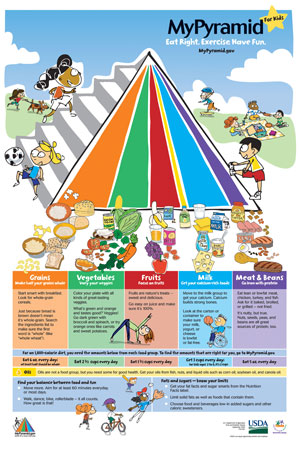
Dinner can be a stressful time with preschool-aged children. Balancing a parent’s need to provide a healthy diet for their offspring with the child’s need to drive their parents crazy, can make mealtime a battle of the vegetables.
It can be difficult to know how much a child needs; what’s too much, what’s too little, what to require, what to allow, and how to find a compromise on both ends of the spoon.
Sarah Krieger, Registered Dietician and spokesperson for the American Dietetic Association, asserts that hungry children are more likely to try new foods, but many times don’t get the chance to work up an appetite. “Kids will eat the most nutritious food when they are hungry, but so many parents give snacks throughout the day, and many of them are not nutritional winners, like cheese crackers, fruit drinks, and fruit snack candy. If you want them to eat well, give them
the good stuff when they’re really hungry.”
In terms of minimum nutritional priorities, Krieger says that a three or four-year-old child should consume two daily servings of dairy, such as a cup of milk, and cup of yogurt, but no more than that amount, plus two to three cups of fruits and vegetables.
“And preferably, not all of that in juice. Only one, eight ounce serving of juice is appropriate.” Krieger believes a child’s hunger should be the criteria for how much they eat. “Just like adults, some days we’re hungrier than others. It’s really important to let the child guide the appetite, while the parents provide healthy food.”
Another point to consider is the disparity of taste buds children of this age have compared to their grown up counterparts. Adults have about 10,000 taste buds on the tongue, but youngsters have more, with some distributed in the cheeks, so some foods can overwhelm them. Krieger suggests that parents don’t salt or pepper their child’s food, but rather add herbs and seasonings a little at a time. “What is strong to them, might be mild to us.”
In addition, don’t give up on foods a child may initially reject, she says that “If a child refuses broccoli after one time that you served it, offer it in many varieties, raw, cooked, in sauces, or in salads, until the child accepts the new food.”
Although the nuts and bolts of a child’s nutrition are important to know, many parents will tell you that knowing what’s good for them and getting them to ingest the same can be a difficult proposition at best.
In the vein of making eating fun, parents and children can visit, www.nutritionexploration.org, which provides interactive games promoting healthy eating. Another tactic is searching “kids and vegetables” through any major bookstore with kids books, CDs and DVDs.
As far as adult readers, Jessica (wife of Jerry) Seinfeld, has devoted an entire cookbook to the mission of tricking kids into eating, titled, Deceptively Delicious: Simple Secrets to Get Your Kids Eating Good Food, published by Harper Collins, in which recipes run the gamut from brownies to eggs with cauliflower.
With all the advice available, it seems that picky eaters should be a thing of the past, but some frustrated parents continue to face a harvest of fruits and veggies only they will eat. A good source of tried and true advice can be found online where parents can Google phrases such as “Preschool Nutrition” to find chat rooms on the subject.
 A recent visit to www.Tricitymom.com, and www.fatherhood.org, resulted in a number of practical ideas, including a mom who finds her child will eat veggies, if she can finger pick them. Another parent suggests showing children how food is grown, and letting them try to raise a crop of their own. Both are worth a try, but the majority of parent-tested ideas fall into the secret ingredient category.
A recent visit to www.Tricitymom.com, and www.fatherhood.org, resulted in a number of practical ideas, including a mom who finds her child will eat veggies, if she can finger pick them. Another parent suggests showing children how food is grown, and letting them try to raise a crop of their own. Both are worth a try, but the majority of parent-tested ideas fall into the secret ingredient category.
According to moms and dads in the trenches, there are many places to hide fruits and veggies, such as blending peas into mashed potatoes, covering them in salad dressing or ketchup, and adding shredded zucchini to banana muffins. Pizza and pasta are hailed as two of the best receptacles for the covert veggies.
Still, the best-laid parental plans can be in vain. One parent diligently and secretively shredded carrots into her young son’s macaroni and cheese. Over the course of the next few weeks, mom proceeded to share her secret with friends and feel a sense of accomplishment. Then, one day, her little boy approached her in the kitchen and said, “Mommy, can I have macaroni and cheese, and please leave out the carrots.”
